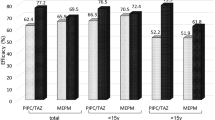Summary
A prospective, randomized clinical trial comparing combination therapy with ceftriaxone and teicoplanin versus ceftazidime and teicoplanin in the treatment of febrile episodes in neutropenic cancer patients and bone marrow transplant recipients was performed. One hundred and two patients were randomized, but two patients were considered unevaluable for efficacy, and three patients were withdrawn due to incorrect randomization. Of the remaining 97 patients, infection resolved without modification of therapy in 31/49 (63%) patients treated with ceftriaxone/teicoplanin versus 27/48 (56%) patients treated with ceftazidime/teicoplanin (P=0.48). Of all 97 patients treated therapy was modified in 18/49 (36%) with ceftriaxone/teicoplanin and 21/48 (43%) with ceftazidime/teicoplanin. Nineteen patients treated with ceftriaxone/teicoplanin received netilmicin and 21 patients treated with ceftazidime/teicoplanin also received netilmicin according to the study design (escalation therapy). When netilmicin was added infection resolved in 78% of patients treated with ceftriaxone/teicoplanin versus 84% of those treated with ceftazidime/teicoplanin. It was concluded that combination therapy with ceftriaxone/teicoplanin is an alternative to combination therapy with ceftazidime/teicoplanin, and has the advantage of once daily administration.
Zusammenfassung
In einer prospektiven, randomisierten klinischen Studie wurde die Kombinationstherapie mit Ceftriaxon und Teicoplanin gegen die Kombinationspartner Ceftazidim und Teicoplanin bei neutropenischen Patienten oder Patienten nach Knochenmarktransplantation verglichen. Insgesamt wurden 101 Patienten in die Studie eingebracht, davon waren 97 Patienten auswertbar. In der Ceftriaxon/Teicoplanin-Gruppe waren 63% der Patienten geheilt, gegenüber 56% der Patienten in der Ceftazidim/Teicoplanin-Gruppe. Dieses Ergebnis war ohne Modifikation der Studien-Medikamente erreicht worden. Bei 18 von 49 Patienten in der Ceftriaxon/Teicoplanin-Gruppe und 21 von 48 Patienten in der Ceftazidim/Teicoplanin-Gruppe wurde von der Studienmedikation abgegangen und zusätzlich Netilmicin (Eskalationstherapie) gegeben. Durch die zusätzliche Gabe von Netilmicin waren 78% der Patienten in der Ceftriaxon/Teicoplanin-Gruppe und 84% in der Ceftazidim/Teicoplanin-Gruppe geheilt. Diese Daten deuten darauf hin, daß die Kombinationstherapie mit Ceftriaxon/Teicoplanin eine Alternative zur Kombinationstherapie mit Ceftazidim und Teicoplanin darstellt, zumal die Gabe von Ceftriaxon und Teicoplanin den Vorteil hat, daß diese Medikamente nur einmal pro Tag gegeben werden müssen.
Similar content being viewed by others
References
Klastersky, J. Management of infection in granulocytopenic patients. J. Antimicrob. Chemother. 12 (1983) 102–104.
Meunier F. Infections in patients with acute leukemia and lymphoma. In:Mandell, G. L., Douglas, R. G., Bennett, J. E. (eds. Churchill Livingstone, New York 1989, pp. 2265–2275.
de Pauw, B. E., Feld, R., Deresinski, S., Donnelly, J. P., Lane-Allman, E.: Multicentre, randomized, comparative study of ceftazidime versus piperacillin + tobramycin as empirical therapy for febrile granulocytopenic patients. In: Proceedings of the 6th International Symposium on Infections in the Immunocompromised Host, 1990, 116A.
Report of a Consensus Panel of the Immunocompromised Host Society The design, analysis and reporting of clinical trials on the empirical antibiotic management of the neutropenic patient. J. Infect. Dis. 161 (1990) 397–401.
Working Committee of the Infectious Diseases Society of America Guidelines for the use of antimicrobial agents in neutropenic patients with unexplained fever. J. Infect. Dis. 161 (1990) 381–396.
Kelsey, S. M., Collins, P. W., Delord, C., Weinhard, B., Newland, A. C. A randomized study of teicoplanin plus ciprofloxacin versus gentamicin plus piperacillin for the empirical treatment of fever in neutropenic patients. Br. J. Haematol. 76 (1990) (Suppl. 2) 10–13.
Verhagen, C. S., de Pauw, B., de Witte, T., Janssen, J., Williams, K., de Mulder, P., Bothof, T. Randomized prospective study of ceftazidime versus ceftazidime plus cephalothin in empiric treatment of febrile episodes in severely neutropenic patients. Antimicrob. Agents Chemother. 31 (1987) 191–196.
Pizzo, P. A., Hathorn, J. W., Hiemenz, J., Browne, M., Commers, J., Cotton, D., Gress, J., Longo, D., Marshall, D., McKnight, J., Rubin, M., Skelton, J., Thaler, M., Wesley, R. A randomized trial comparing ceftazidime alone with combination antibiotic therapy in cancer patients with fever and neutropenia. N. Engl. J. Med. 315 (1986) 552–558.
Anonymous, Report of a Consensus Panel: The design, analysis and reporting of clinical trials on the empirical antibiotic management of the neutropenic patient. J. Inf. Dis. 161 (1990) 397–401.
Wade, J. C., Schimpff, S. C., Newman, K. A., Wiernik, P. H. Staphylococcus epidermidis: an increasing cause of infection in patients with granulocytopenia. Ann. Intern. Med. 97 (1982) 503–508.
Meunier, F., Zinner, S. H., Gaya, H., Calandra, T., Viscoli, C., Klastersky J. Prospective randomized evaluation of ciprofloxacin versus piperacillin plus amikacin for empiric antibiotic therapy of febrile granulocytopenic cancer patients with lymphomas and solid tumors. Antimicrob. Agents Chemother. 35 (1991) 873–878.
Bodey, G. P., Fainstein, V., Elting, L. S., Anaissie, E., Rolston, K., Khardori, N., Kantarjian, H., Plager, C., Murphy, W. K., Holmes, F., Cabanillas, F. Beta-lactam regimens for the febrile neutropenic patient. Cancer 65 (1990) 9–16.
Ramphal, R., Kramer, B. S., Rand, K. H., Weiner, R. S., Shands, J. W., Jr. Early results of a comparative trial of ceftazidime versus cephalothin, carbenicillin and gentamicin in the treatment of febrile granulocytopenic patients. J. Antimicrob. Chemother. 12 (Suppl. A) (1983) 81–88.
Donnelly, J. P., Marcus, R. E., Goldman, J. M., Cohen, J., Worsley, A. M., Catovsky, D., Darrell, J. H., Want, S. V., Galton, D. A. Ceftazidime as first-line therapy for fever in acute leukemia. J. Infect 2 (1985) 205–215.
Indravadan, H., Patel, Ph. D., Stanley, A., Kaplan, Ph. D. Pharmacokinetic profile of ceftriaxone in man. Am. J. Med., October 19, (1984) 704–710.
Liang, R., Yung, R., Chiu, E. Ceftazidime versus imipenem-cilastatin as initial monotherapy for febrile neutropenic patients. Antimicrob. Agents Chemother. 34 (1990) 1336–1341.
Lang, E., Schmid, J., Fauser, A. A. A clinical trial on efficacy of teicoplanin in combination with beta-lactams and aminoglycosides in the treatment of severe sepsis of patients undergoing allogeneic/autologous bone marrow transplantation. Br. J. Haematol. 76 (1990) 302.
Author information
Authors and Affiliations
Rights and permissions
About this article
Cite this article
Fauser, A.A., Lang, E., Köchling, G. et al. A randomized clinical trial of ceftriaxone and teicoplanin versus ceftazidime and teicoplanin as antibiotic therapy in febrile neutropenic cancer patients and bone marrow transplant recipients. Infection 22, 271–275 (1994). https://doi.org/10.1007/BF01739915
Received:
Accepted:
Issue Date:
DOI: https://doi.org/10.1007/BF01739915




